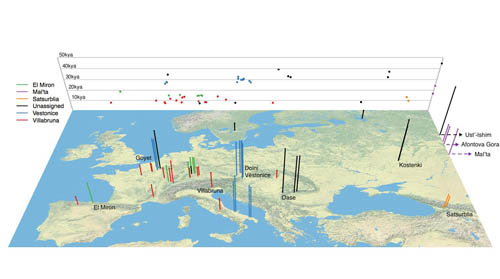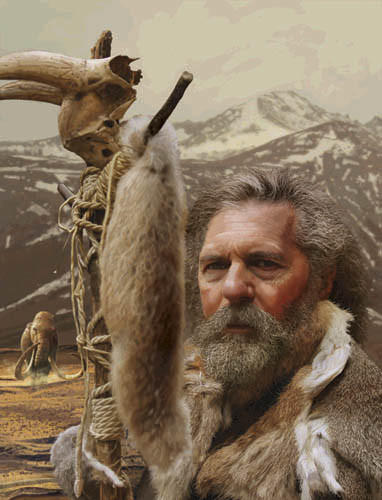Drawing the Genetic History of Ice Age Eurasian Populations
Not much is known about the genetics of Eurasian history before the introduction of farming. One of the major questions is how climatic fluctuations influenced the population history of Eurasia and to what extent changes in material cultures correspond to movements of people.
A research team led by Prof. FU Qiaomei from the Institute of Vertebrate Paleontology and Paleoanthropology (IVPP ), Chinese Academy of Sciences and other international scientists (Profs. David Reich, Svante P??bo and Johannes Krause) has analyzed genome-wide data from 51 Eurasians from ~45,000-7,000 years ago and provided the first vivid look at the genetic history of modern humans in Eurasia before the start of agriculture ~8,500 years ago. Their findings were published in Nature on May 2.
The findings indicate that the proportion of Neandertal ancestry in Eurasians decreased from 3-6% to around 2% over this period of time,and the decrease is more marked near genes than in less conserved regions of the genome, suggesting natural selection against Neandertal variants in modern humans.
Whereas some of the earliest modern humans in Europe, such as the 40,000- to 45,000-year-old Ust’-Ishim and Oase 1, did not contribute substantially to present-day Europeans, all individuals between ~37,000 and ~14,000 years ago descended from a single founder population which forms part of the ancestry of present-day Europeans. An ~35,000-year-old individual from northwest Europe represents an early branch of this founder population which was then displaced across a broad region, before reappearing in southwest Europe at the height of the last ice age ~19,000 years ago. This means that the Neanderthals might have had more inferior genes that their part did not manage to survive in the evolution.
"A new genetic component related to present-day Near Easterners appears in Europe during the first major warming period around 14,000 years ago, which may reflect migrations or population shifts within Europe at the end of the last ice age, an observation that is consistent with the evidence of turnover of mitochondrial genomes at this time", said lead author FU Qiaomei of the IVPP, "it could be the warming weather rather than development of agriculture - as it was previously believed - that drove early Near East residents to Europe and led to the gene fusion."
Overall, these results document how population turnover and migration have been recurring themes in European pre-history. An important direction of future work will be to generate genetic data from ancient individuals from East Asia, southeastern Europe and the Near East, which will provide further insights into the Upper Paleolithic population history of Eurasia.
"Previous researches usually include genome-wide data on only one or two Upper Paleolithic individuals. But this research managed to collect valid genome-wide data from 51 individuals from a more than 100 sample bases," said study co-supervisor Svante P??bo, a professor of the Department of Evolutionary Genetics, Max Planck Institute for Evolutionary Anthropology, "Prior to this work, we had a static view of the first 30,000 years of modern human history in Europe. Now we can begin to see how people moved around and mixed with one another during this period."
The ancient DNA laboratory led by FU Qiaomei at the IVPP will focus on addressing the role of East Asia during the Upper Paleolithic. Currently, the main purpose of this laboratory is to research topics in evolutionary and population genetics, using molecular genetic approaches to clarify ancient human relationships, archaic hominid introgression into modern humans, migratory routes of early modern humans into Asia and interactions between early modern humans and contemporary local modern humans.
This research was supported by the Special Foundation of the President of the Chinese Academy of Sciences, the Bureau of International Cooperation of the Chinese Academy of Sciences, and the National Natural Science Foundation of China.

Fig.1 Location and age of the 51 Eurasians from ~45,000-7,000 years ago (Each bar corresponds to an individual, the colour code designates the genetically defined cluster of individuals, and the height is proportional to age) (Image by FU Qiaomei )

Fig.2 Impression of one of the Ice Age modern humans analyzed in this study (Image by Stefano Ricci who is both a professional graphic artist and an author. Credit and copyright: Stefano Ricci (stefano.ricci@unisi.it) )
Download attachments: